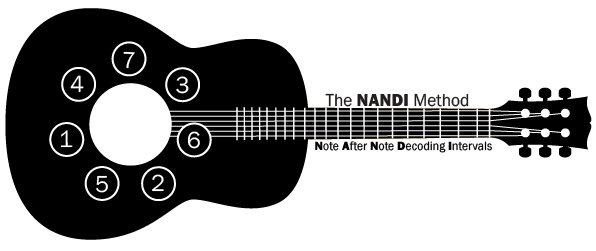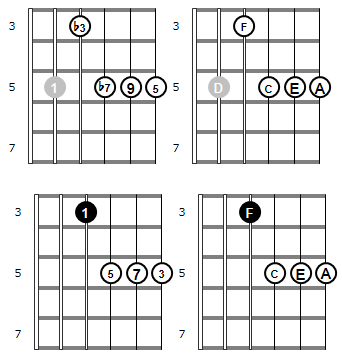Functional Harmony: Diatonic Chord Substitution
Chord substitutions occur when you substitute one chord for another based on tonal function. In order to understand how chord substitution works, you must first know that the seven diatonic chords fall into three families:
- Tonic (stable chords)
- Subdominant (semi-stable chords)
- Dominant (unstable chords)
Tonal functions is about the stability (stable/unstable) of a chord in the key. Every diatonic scale contains a tritone (an interval of 6 half-steps, also known as a #4 or ♭5). Let’s look at this in the key of C major.
The tritone in the key of C major is from B to F (7-4). A chord’s tonal stability is determined by whether it has one, both, or neither of these notes.
Tonic:
Diatonic chords built off of the first, third and sixth scale degrees are the most stable and referred to as the tonic chords. In the key of C they are:
CMaj7 (I) – Em7 (iii) – Am7 (vi)
The most unstable note F (4) is not present in these tonic chords.
These chords are interchangeable because they have the same tonal stability. So you can substitute any of these chords for the other.
For example, to substitute a Cmaj7 chord, you can go up a major 3rd from root C and play an Em7, or go down a minor 3rd and play an Am7.
You can substitute a Cmaj6 (C-E-G-A), also a tonic chord, with an Am7 (A-C-E-G) whose root is up a major sixth/down a minor third from C. These chords share the same notes. Below is a Cmaj6 with 6 in the bass (6-3-5-1) and an Am7 with root in the bass (1-5-♭7-♭3) :
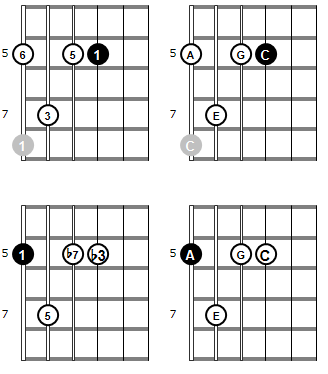
Similarly, you can substitute a Cmaj7 with a minor seventh chord whose root is a major third from C (E–G–B–D). The resulting chord is Em7/C, or a Cmaj7 (9). Below, the top diagrams show the scale degrees for a Cmaj7 (9), while the bottom diagrams shows the same fretting with the scale degrees for an Emin7.
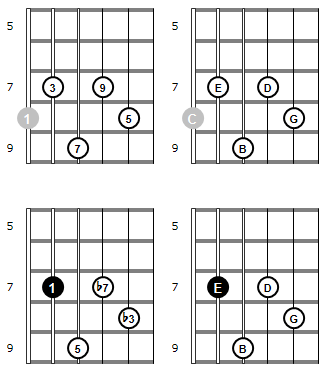
Subdominant:
Semi-stable chords with the subdominant function are built on the second and the fourth scale degrees. In the key of C these chords contain F (4) but not B (7), they are:
Dm7 (ii) – Fmaj7 (IV)
You can substitute a Dm7 with a chord that is a minor third up from its root which is an Fmaj7. Similarly, you can go down a third from the root of Fmaj7 and play a Dm7 (9).
Both these chords have the same stability, and share 3 notes in common – F, A and C.
Dominant:
The most unstable diatonic chords are built on the fifth and seventh scale degrees. In the key of C they are:
G7 (V) – Bm7(♭5) (vii°)
Since these chords contain both notes F and B, they are the least stable.
You can substitute a G7 chord (G-B-D-F) with a Bm7(♭5) -(B-D-F-A) whose root is a major third up from G . This is a half-diminished seventh chord. The distance from the major third (3) to the minor seventh (♭7) in the dominant chord, and the root (1) to the diminished fifth (♭5) in the half-diminished chord is a tritone. That’s what makes these chords so unstable.

Tritone Substitution
In the key of C, the very unstable G7 dominant chord (G-B-D-F) wants to resolve up a fourth (C) to a more stable chord because of the tritone or augmented fourth that is between the 3 (B) and the ♭7 (F) of the dominant chord. These notes “want” to move in opposite directions and get to the root and third of the target chord. So when you have a G7, the third (B) and the seventh (F) want to move in opposite directions, the B up to C, and the F down to E which is the root and third of C. In the key of C, the very unstable G7 dominant chord (G-B-D-F) wants to resolve up a fourth (C) to a more stable chord because of the tritone or augmented fourth that is between the 3 (B) and the ♭7 (F) of the dominant chord. These notes “want” to move in opposite directions and get to the root and third of the target chord. So when you have a G7, the third (B) and the seventh (F) want to move in opposite directions, the B up to C, and the F down to E which is the root and third of C.
You have a tritone substitution when you substitute a dominant chord with another dominant chord whose root is a tritone away. For example, substitute a G7 with a D♭7 (G to D♭ is a tritone.)
The 3 and ♭7 of the original chord is the same as the ♭7 and 3 of the substituted chord (3 and ♭7, ♭7 and 3 are tritones). In a G7 chord, the notes B (C♭) and F are the 7th and 3rd of D♭7, so this means that the same tritone exists in both chords.
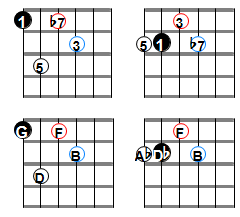
Because both dominant chords share the same tritone, and are a tritone apart from each other, they can substitute each other.
You can use either a G7 (G-B-D-F) or D♭7 (D♭-F-A♭-C♭/B) to resolve to C .
